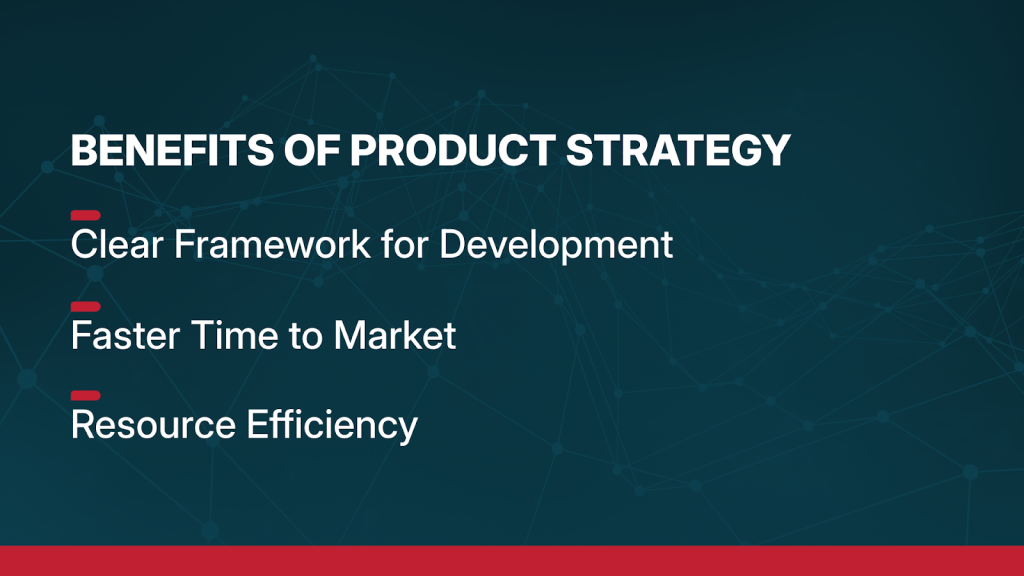The Power of Early Product Strategy for Streamlined Development

- What is Product Strategy in Product Development?
- Why Product Strategy Matters in Product Development
- User-Centered Design: The User Advocate
- Systems Engineering: The Product Advocate
- The Catalytic Impact of UCD and Systems Engineering
- Putting Product Strategy into Practice
- Summary: The Advantage of a Strong Product Strategy Process
In today’s competitive market, the ability to develop products that meet user needs while remaining commercially viable is essential. But how can teams ensure they are on the right path from the start?
The answer lies in a structured approach that brings together the right balance of product desirability, business viability, and engineering feasibility to drive a solution framework. This process of product strategy is a launching pad for full-scale product development. To develop innovative and highly complex electronic products, this process works best when User-Centered Design (UCD) and Systems Engineering collaborate to create a clear direction for successful product development.
By answering two critical questions—“Are we making the right product?” and “Are we making the product right?”—a strong product strategy phase avoids the pitfalls of jumping straight into developing products without the right frameworks in place. With this approach, teams first create solution-neutral frameworks tailored to user needs, business goals, and technological capabilities that lay the groundwork for powerful and efficient product development.
What is Product Strategy in Product Development?
Product strategy is the process of thoroughly understanding and articulating the needs, goals, and constraints of a product before any development begins. A great process involves creating a framework that clarifies how a product will be used, aligns with brand values, and meets business case and technical requirements without dictating specific design solutions prematurely. The product strategy process emphasizes a solution-neutral approach to create objective decision frameworks that align the business case, user needs, and technical feasibility.
Two key roles are essential in this process:
- User-Centered Design (UCD): The User Advocate—UCD ensures that the product delivers a meaningful user experience that meets usability criteria and delivers on the brand promise.
- Systems Engineering: The Product Advocate—Systems engineering maintains a holistic view of the product, mapping out its functions and ensuring feasibility in technical implementation and manufacturing.

Why Product Strategy Matters in Product Development
When product development teams latch on to solutions too early, it can create blind spots and biases in their ability to evaluate all of their stakeholder needs. Doing this, they risk missing critical steps that ensure the product’s relevance and feasibility. Without a structured product strategy process, teams can waste time and resources on developing products that ultimately fail to satisfy user needs or are too costly to produce. It’s like planning a dinner menu without understanding your guests’ dietary restrictions and aversions.
A formal product strategy process provides:
- A Framework for Success: Objective measures to align business goals, user needs, and technical requirements.
- A Focus on Value: Ensures that development teams spend time on the right aspects.
- Cost and Time Efficiency: Reduces iterations by clearly establishing product solution spaces up front to accelerate time to market.
User-Centered Design: The User Advocate
User-Centered Design (UCD) is a collaborative, creative problem-solving approach to product development. The process prioritizes user needs, while balancing them with technology and business opportunities. UCD acts as the bridge between marketing vision and engineering realities, translating user expectations into actionable design criteria. User-centered design principles promote empathy for users, allowing design teams to anticipate needs and constraints while creating products that provide meaningful solutions.
UCD goes beyond simply listing user needs; it helps create frameworks that guide every design decision with user relevance in mind. With this approach, design teams become “User Advocates,” ensuring that each touchpoint in the product experience meets the usability needs and delivers on the brand promise.
By putting the user at the center, UCD addresses common development challenges, including:
- Designing for User Needs: Developing products that resonate with users and address their pain points will reinforce brand promise.
- Aligning Expectations Across Teams: Establishing a shared understanding of the ideal workflow and user experience before concept development.
- Reducing Product Redesigns: Minimizing costly changes by defining user-focused goals and viable workflows upfront.
Systems Engineering: The Product Advocate
While UCD focuses on the user, Systems Engineering ensures the product’s functionality, manufacturability, and scalability. Acting as the “Product Advocate,” systems engineers maintain a holistic view of the product, guiding its development by defining its core functions and use cases.
Systems Engineering plays a crucial role in managing the complex requirements of modern products, which often include multiple subsystems and diverse technical constraints. Systems engineers ensure that the product remains aligned with business goals and can evolve as project requirements shift. They also ensure the design process incorporates manufacturing scalability, critical for successful market entry.
Key contributions of Systems Engineering include:
- Maintaining Technical Feasibility: Ensuring the product can be developed within available resources and maintaining the right functional priorities.
- Enabling Holistic Oversight: Systems engineers connect the work of specialized engineering teams on subassemblies to the total project.
- Supporting Long-Term Viability: Developing scalable solutions that align with manufacturing and market goals.
The Catalytic Impact of UCD and Systems Engineering
The real power of product strategy emerges when UCD and Systems Engineering work together. This collaboration creates a structured, solution-neutral foundation that clarifies both what the product needs to do for users and the technical specifications required for its development. Here’s how this combination streamlines product development:
- Clear Framework for Development: By developing a comprehensive product strategy, teams have a shared roadmap that guides them through design, engineering, and testing. This clarity allows the team to zoom out and see the bigger purpose of the product while focusing on precise functional and aesthetic requirements.
- Faster Time to Market: A clear product strategy aligns the team’s efforts from the start, reducing missteps and enabling a faster development cycle. Defined goals and requirements help avoid extensive revisions, resulting in a quicker, smoother path to a successful product launch.
- Resource Efficiency: By reducing the need for redesigns and clarifying guidelines upfront, the product strategy process saves both time and resources. Efficient use of resources helps teams avoid costly product design changes and rework during development.

Putting Product Strategy into Practice
Starting with a well-structured product strategy process ensures that the entire development journey—from initial concept to final design—is guided by clear objectives. This means gathering all relevant information about the product, including:
- User requirements and usage contexts
- Business objectives and brand considerations
- Technical feasibility and manufacturing constraints
This approach captures essential inputs without prescribing a specific solution, allowing for creative and technical flexibility during development. In this way, product strategy provides a solid foundation upon which the final product can be built, balancing innovation with practicality.
There are several benefits to outsourcing design and engineering services for the product strategy process. Using an external partner brings a neutral third party into the process to ensure all product priorities are balanced. Finding a partner with depth of expertise in the process will also ensure no blind spots or biases impact the development of a strong product framework. If the engineering services provider is part of a contract manufacturing business, engineers should be well-versed in designing for efficient production. A strong external engineering team will be able to guide development to ensure the product is ready for large-scale manufacturing.
Summary: The Advantage of a Strong Product Strategy Process
For organizations seeking to deliver products that resonate with users and succeed in the market, investing in a formal product strategy process is a strategic advantage. By combining User-Centered Design and Systems Engineering, product developers can ensure they create the right product for the right audience while keeping development streamlined and efficient. These processes can be executed by internal teams or engineering services companies.
With this approach, companies don’t just bring products to market; they bring solutions that fulfill their brand promise, meet user needs, and achieve sustainable growth.
Contact Plexus
Plexus has decades of experience partnering with innovators to develop the world’s most transformative products. Our industrial designers and systems engineers work collaboratively to bring your ideas into reality. Contact our team to learn more about how we partner.
- What is Product Strategy in Product Development?
- Why Product Strategy Matters in Product Development
- User-Centered Design: The User Advocate
- Systems Engineering: The Product Advocate
- The Catalytic Impact of UCD and Systems Engineering
- Putting Product Strategy into Practice
- Summary: The Advantage of a Strong Product Strategy Process


